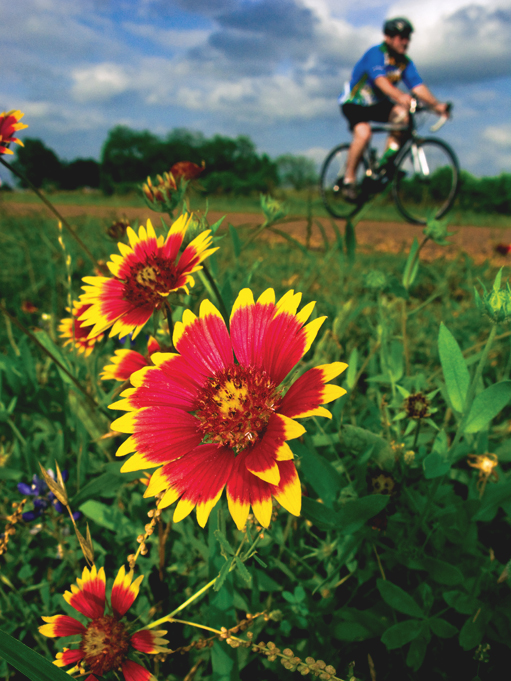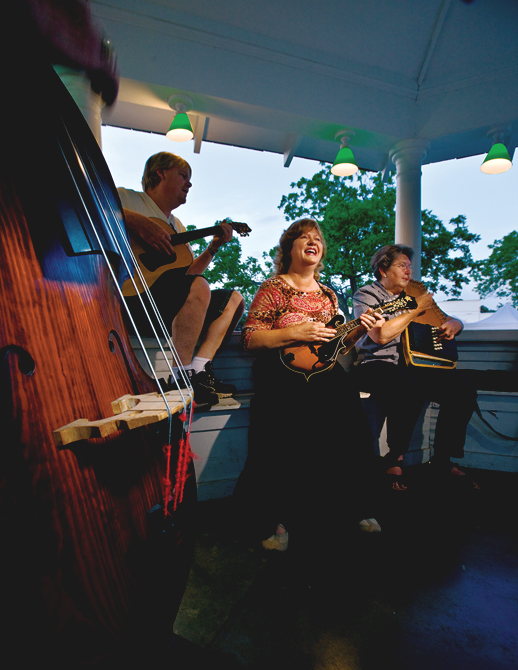 A bicycling mecca with bucolic byways, Fayetteville hosts a stage reace every spring. (Photo by J. Griffis Smith) It’s six o’clock on a Saturday evening in Fayetteville, and Clovis Heimsath is spontaneously holding court in the lobby of his Country Place Hotel, a 1900 mercantile remodeled into a country inn. Relaxing in an antique rocking chair, Heimsath regales three visitors from Houston, along with my girlfriend, Lindy, and me, with tales of the town’s history. Heimsath relates that members of Stephen F. Austin’s original 300 first settled here nearly two centuries ago, followed by German and then Czech (and later Czech-Moravian) immigrants. Today, the town (population 261), situated midway between Austin and Houston, draws an eclectic mix of visitors: Motorcyclists refuel their gas tanks, and then fill their stomachs with monstrous, double-meat burgers from Orsak’s Cafe on the historic square; anglers cast for bass in Fayette Lake; shoppers browse the town’s five antiques stores; and art buffs seek out the 19th-Century paintings hanging in a local church.  On second Saturdays from April through November, the popular Texas Pickin’ Park event attracts musicians to the town square for acoustic jam sessions. (Photo by J. Griffis Smith) I’ve visited the area annually for a decade now. Every March, just as the bluebonnets and Indian paintbrush burst into bloom across the area’s rolling countryside, the Fayetteville Stage Race—like the Tour de France, but on a much smaller scale—draws hundreds of cyclists. The winding maze of quiet country roads, gentle hills, and step-back-in-time scenery make the Fayetteville area a paradise for biking. Two-wheeled tourists range from somewhat obsessive racers like me, to the more recreational-minded folks. The Fayetteville Stage Race, promoted by Houston’s Southwest Cycling Club, consists of three events over two days, with some courses as long as 100 miles. For less competitive cyclists, the annual MS-150 charity ride rolls through Fayetteville on its route between Houston and Austin every April. A few weeks prior to last year’s Fayetteville bike race, I took an opportunity to explore the town’s amenities, in addition to pedaling its bucolic countryside. Luckily, Heimsath, a former head of the Fayetteville Chamber of Commerce, thrives in the role of tour guide. Guests staying in one of the Country Place’s eight simply appointed rooms (think antiques, iron bedsteads, colorful “Today, Fayetteville is experiencing a renaissance,” Heimsath says. In addition to physical restoration, the influx of outsiders expanded the town’s cultural offerings, which include the Fayetteville Chamber Music Festival featuring world-renowned musicians, and an annual Art Walk on the town square. On this evening, Heimsath suggests that Lindy and I attend a concert at the Art Guild of Rural Texas. A nonprofit organization founded in 2003, the Art Guild brings performing arts, such as the Houston Grand Opera, to the schools in and around Fayetteville, but it also regularly provides concert and gallery showings for the general public. The sun has already set by the time Lindy and I step out onto the Country Place’s expansive wooden porch on our way to the concert. I inhale a deep breath of the crisp, clean air and gaze at the blanket of stars overhead. We stroll across a thick bed of green grass surrounding the gleaming Fayette County Precinct Courthouse—constructed in 1880 and in 1934 adorned with a four-sided Seth Thomas clock—and enter the Art Guild headquarters building on the other side of the square. Before the show, featuring Houston area pianist Johnny Wilson, Lindy and I chat with Art Guild co-founder Mike Clann and his wife, Linda, over a spread of hors d’oeuvres that includes a tasty pate. The Clanns live somewhat of a double life. During the week, they’re based in Houston, where Mike works as an attorney. On weekends, they escape to the countryside, immersing themselves in Fayetteville’s rural charm and burgeoning culture. Mike, an accomplished watercolor and acrylic painter, shares an art studio behind the Country Place Hotel with Heimsath, whose large oil paintings of local scenes and nature decorate the walls of his hotel. (Glass artist Dick Bour, noted potter Pat Johnson, photographer Jerry Brown, and other artists also have studios and gallery spaces on and around the square.) Seated behind a glossy black grand piano, Wilson starts the show. He showcases a musical repertoire ranging from classical to hits from Willie Nelson-all while engaging the crowd with stories from his travelsaround the globe. “This is as good as anythingwe get in Houston;’ Linda whispers. Later that evening, Lindy and I slip next door to grab dinner at Joe’s Place, which occupies an 1890 building that once housed Baca’s Historic Saloon & Confectionary. The blackened tenderloin steak I order comes sprinkled with bleu cheese crumbles and topped with tobacco-onion strings. Lindy slices into a lightly breaded mahi-mahi fillet topped with crabmeat and a side of asparagus drizzled with hollandaise sauce. A couple of Shiner Blondes on draft perfectly complement our dishes. The following morning, Lindy and I savor the Country Place breakfast of mini-quiches, fresh fruit, and stout coffee, then make a short walk to St. John’s Catholic Church. We want to see the church’s recently rediscovered and restored theological paintings, originally commissioned from the prolific Moravian However, as we approach the creamcolored brick church, we notice the congregation gathered behind the building, where two rows of barbecue pits sit under a long tin roof. Once a month, it turns out, men from the Fayetteville chapter of the Knights of Columbus wake up well before dawn and fire up a couple of pits to barbecue a hundred-plus chickens. Townsfolk line up, and at seven dollars apiece, the barbecued birds typically sell out by 11 a.m. The pitmaster’s charcoal-stained shirt reads, “It always tastes right when served by a knight!’ Inside the church, current priest Father Stephen Nesrsta, of Czech ancestry, welcomes us. According to Father Nesrsta, in 2002, the previous pastor happened upon a painting stored in the rectory. He learned of the artwork’s historical significance, and soon after, discovered five more paintings that had been stored in other locations long ago by the church. Three of the paintings had been placed in the Fayetteville Area Heritage Museum on the square for safekeeping. Thanks to generous donations from the community, the church succeeded in fully restoring all six paintings. The first painting we see, depicting St. Martin of Tours, graces the entryway to the church, while the five other immense artworks-each framed in hand-gilded, 24-karat gold molding hang in a row above the altar. The display mimics their position in the original 1870s church. The largest painting, Father Nesrsta recommends we also visit the ornate St. Mary Catholic Church near Ellinger, six miles to the south. To Lindy and me, this Built in the mid-1800s, the church sits on a hill overlooking the surrounding countryside. Before entering, Lindy and I peer back toward the iconic silver water tower in town—dubbed the “Tin Man’s head” and the blinking lights of the Fayette power plant farther in the distance. Inside the small sanctuary, rows of wooden pews lead to a massive white altar spanning the width of the building. The altar’s Baroque design features decorative, painted carvings of various saints and patrons, each accented with gold highlights. The return ride to Fayetteville inspires a long cut down a narrow dirt road, across a tree-covered creek bed. Shortly before reaching town, we pass a timeless Texas sight-a sea of brilliant bluebonnets. The field proves so stunning it almost appears groomed. Later, as we check out of the Country Place, Heimsath assures me that the flowers grow naturally and, like everything else we’ve seen, are embedded in Fayetteville’s history. |








